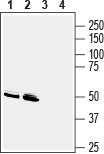Overview
- Peptide (C)RRYGAESQNPTVK, corresponding to amino acid residues 59-71 of mouse GPR83 (Accession P30731). Extracellular, N-terminus.
- Mouse and rat brain membranes; human Jurkat T-cell leukemia cell lysate (1:400-1:2000).
 Western blot analysis of mouse brain membranes (lanes 1 and 3) and rat brain membranes (lanes 2 and 4):1, 2. Anti-GPR83 (extracellular) Antibody (#AGR-053), (1:400).
Western blot analysis of mouse brain membranes (lanes 1 and 3) and rat brain membranes (lanes 2 and 4):1, 2. Anti-GPR83 (extracellular) Antibody (#AGR-053), (1:400).
3, 4. Anti-GPR83 (extracellular) Antibody, preincubated with GPR83 (extracellular) Blocking Peptide (#BLP-GR053).
- Human Jurkat T-cell leukemia cells (5µg).
GPR83 (JP05, GIR, GPR72) is a G-protein coupled receptor (GPCR) highly expressed in the brain, spleen and thymus, suggesting that this receptor may be targeted to treat neurological and immune disorders1.
GPCR is a family of receptors responsible for initiation of a myriad of intracellular signaling cascades, these receptors are characterized by an extracellular N-terminus, intracellular C-terminal tail, and seven membrane-spanning α-helices (TM-1 to TM-7)2.
In the brain GPR83 is expressed in the hippocampus, amygdala, prefrontal cortex, and in various hypothalamic nuclei where it may play a significant role in learning memory, reward, emotional behaviors, and stress regulation3. GPR83 is also expressed in regulatory T cells (Tregs) and it could potentially be used as a specific marker used to identify natural Tregs4.
GPR83 was considered as an "orphan" GPCR. Recently, PEN, a neuropeptide was identified as its endogenous ligand1.
